Pye Telecom History Group - Virtual Pye
Museum
|
||||||||
Pye Telecom History Group - Virtual Pye
Museum
|
||||||||
|
|
|||||||||||||||||||||||||||||||||||||||||
|
|
|||||||||||||||||||||||||||||||||||||||||
|
PTC122/123/124
Walkie-Phone (1951)
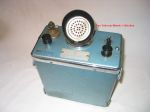 The
PTC122 series VHF 'Walkie-Phones' were designed in the early 1950s to
provide low-power, light weight, short range The
PTC122 series VHF 'Walkie-Phones' were designed in the early 1950s to
provide low-power, light weight, short range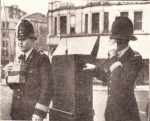 portable
communication. The equipment was a 6 valve crystal controlled AM
transmitter and receiver, and was generally carried on the chest of the
operator. A built-in top mounted microphone was used, together
with external
headphones and a flexible tape antenna. Single channel, 3 channel
and 6 channel versions were produced, and the equipment was available
in
two basic variants, one with internal batteries, the other with an
external
battery-pack. See equipment inside
top view, inside left view
and right view and also
the underside view. portable
communication. The equipment was a 6 valve crystal controlled AM
transmitter and receiver, and was generally carried on the chest of the
operator. A built-in top mounted microphone was used, together
with external
headphones and a flexible tape antenna. Single channel, 3 channel
and 6 channel versions were produced, and the equipment was available
in
two basic variants, one with internal batteries, the other with an
external
battery-pack. See equipment inside
top view, inside left view
and right view and also
the underside view. The equipment pictured above left is the internal battery version. Quantity 8 of the external battery-pack version were used by the British Expedition during the conquest of Mount Everest in 1953. In this application, specially designed batteries were carried in a canvas vest close to the body in order to keep the batteries warm. See photo at right of the equipment in use with the London Police in 1953 during the re-surfacing of Tower Bridge. The earliest dated reference found to the use of the Walkiephone is in the August 1951 Daily Mail Cross Channel Swim, reported in Practical Wireless, Volume 27 No. 540, October 1951, page 453. |
|||||||||||||||||||||||||||||||||||||||||
| Top of page | |||||||||||||||||||||||||||||||||||||||||
|
|
|||||||||||||||||||||||||||||||||||||||||
|
TRP-X1 HF
Walkie-Phone (1953?)
 The Pye-Electronic
Pty Australia TRP-X1 HF
Walkie-Phone was a portable equipment which had a 3
channel crystal controlled transmitter and a continuously variable
tuned
receiver. It covered 1.6 - 4MHz and 4 - 9MHz in two ranges.
The design used 10
miniature wire-ended valves, each about the thickness of a
pencil, all mounted in plug-in sockets. See inside view. The
equipment was self-contained for microphone, loudspeaker and batteries,
and could
have an external telephone handset connected via a front panel
socket. The RF output was 1-5
Watts according to frequency. In use, the
equipment
was normally mounted on the operators chest, suspended from a strap
around the neck. A body strap could also be used to restrain the
equipment. The Pye-Electronic
Pty Australia TRP-X1 HF
Walkie-Phone was a portable equipment which had a 3
channel crystal controlled transmitter and a continuously variable
tuned
receiver. It covered 1.6 - 4MHz and 4 - 9MHz in two ranges.
The design used 10
miniature wire-ended valves, each about the thickness of a
pencil, all mounted in plug-in sockets. See inside view. The
equipment was self-contained for microphone, loudspeaker and batteries,
and could
have an external telephone handset connected via a front panel
socket. The RF output was 1-5
Watts according to frequency. In use, the
equipment
was normally mounted on the operators chest, suspended from a strap
around the neck. A body strap could also be used to restrain the
equipment. The TRP-X1 equipment was very similar in appearance and construction to the UK designed PTC122 series VHF Walkie-Phones of the 1950s, which were generally described as being the first Pye Telecom portable two-way radios. The Pye-Electronic Pty Australia designed HF Walkie-Phones were themselves partly derived from earlier Australian wartime and late 1940s products, some of which confusingly also had the type designation TRP. The origins of the Australian HF Walkie-Phone product family is believed to be the RC-16 equipment (also known by the RAAF as the ATR4-B) first produced by Electronic Industries Limited (EIL) of Australia in 1939. During the War, EIL and Pye Ltd had co-operated over equipment designs and EIL had manufactured the Pye Wireless Sets No. 19 and No. 22. After the war the two companies formed a new company called Pye-Electronic Pty. Ltd. The original RC-16 equipment was redesigned in the late 1940s and marketed as the TRP-1 equipment, although it should be stressed that this early post-war TRP-1 and the later TRP-X1 are physically very different. A matching HF mobile was also produced, the TRM-6, which gave 5-7 watts RF output. |
|||||||||||||||||||||||||||||||||||||||||
| Top of page | |||||||||||||||||||||||||||||||||||||||||
|
|
|||||||||||||||||||||||||||||||||||||||||
|
PF1 Pocketfone (1964)
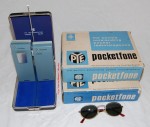 The
PF1 Pocketfone was a
ground-breaking, low-power, two-unit UHF hand-held portable
featuring the transmitter and The
PF1 Pocketfone was a
ground-breaking, low-power, two-unit UHF hand-held portable
featuring the transmitter and receiver in separate
cases. receiver in separate
cases.The design of the PF1 was driven by the Pye Telecom Managing Director John Brinkley, who had formerly worked at the British Home Office. This novel equipment pioneered the application of UHF frequencies for use by hand-held radio schemes in built-up areas and was quickly adopted by the Home Office for wide scale urban and suburban use by the British Police. This first order for the PF1 was for 10,000 pairs of units. Due to the high penetration of UHF frequencies in built-up areas the Pye PF1 quickly found applications such as the London Stock Exchange and London Airport. DC power was provided by single PP3 sized or double PP3 sized rechargeable cells, and several types of single-unit and multi-unit battery chargers were manufactured. Early PF1 receivers used a small postage stamp sized transducer as loudspeaker which gave limited audio performance. Later models used a real moving-coil loudspeaker hence the larger case top profile. This later version was available with simple selective calling facilities to enable the control station to call individual receivers or groups of receivers. |
|||||||||||||||||||||||||||||||||||||||||
| Top of page | |||||||||||||||||||||||||||||||||||||||||
|
|
|||||||||||||||||||||||||||||||||||||||||
|
PF1C Compact (1965)
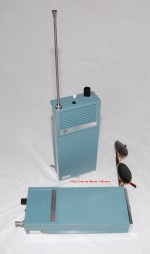 A
single unit UHF hand-held portable containing the PF1T transmitter and
PF1R receiver printed circuit boards mounted in A
single unit UHF hand-held portable containing the PF1T transmitter and
PF1R receiver printed circuit boards mounted in one case, which can be clearly seen
in this inside view. Although larger than the PF1 units, the
PF1C Compact gave users the advantage of a single unit hand-held radio
transceiver. one case, which can be clearly seen
in this inside view. Although larger than the PF1 units, the
PF1C Compact gave users the advantage of a single unit hand-held radio
transceiver.DC power was provided by a single unit PP3 sized rechargeable cell which could be charged in some of the same multi-unit battery chargers used by the PF1 equipments. Like the later PF1 receivers, the PF1C Compact used a real moving coil loudspeaker. The photo at right shows Pye Telecom Salesman Denis Willis demonstrating the equipment to the Mayor of Hounslow. Information to follow |
|||||||||||||||||||||||||||||||||||||||||
| Top of page | |||||||||||||||||||||||||||||||||||||||||
|
|
|||||||||||||||||||||||||||||||||||||||||
|
PF1 Chief Executive
(1967)
 The
Chief Executive was a UHF single channel transportable
transmitter-receiver powered by AC
mains or internal rechargeable batteries. It was effectively a
mains-powered PF1 Compact built into a carrying case and could be
used in either mains powered table-top mode or battery transportable
mode. The
Chief Executive was a UHF single channel transportable
transmitter-receiver powered by AC
mains or internal rechargeable batteries. It was effectively a
mains-powered PF1 Compact built into a carrying case and could be
used in either mains powered table-top mode or battery transportable
mode.The design was originally conceived to provide local communication for the British Prime Minister Harold Wilson when he was at his holiday home in the Isles of Scilly. The example equipment shown in the photograph is serial number 007, and has crystals for the old UHF demonstration base station frequencies, known as 'UHF Dem' in the trade. The equipment featured a removable hand microphone/loudspeaker, a separate built-in loudspeaker and a two section telescopic antenna. Raising the antenna automatically turned on the equipment. Information to follow |
|||||||||||||||||||||||||||||||||||||||||
| Top of page | |||||||||||||||||||||||||||||||||||||||||
|
|
|||||||||||||||||||||||||||||||||||||||||
|
HP1AM & HP1FM
Bantam (1965)
 A range of large
size shoulder-carried, AM and FM, VHF solid state transportable units
using a
separate
plug-in microphone A range of large
size shoulder-carried, AM and FM, VHF solid state transportable units
using a
separate
plug-in microphone and telescopic
antenna. The Bantam series was
the first Pye Telecom VHF portable since the Walkiephone of the early
1950s. and telescopic
antenna. The Bantam series was
the first Pye Telecom VHF portable since the Walkiephone of the early
1950s.Information and internal photographs to follow |
|||||||||||||||||||||||||||||||||||||||||
| Top of page | |||||||||||||||||||||||||||||||||||||||||
|
|
|||||||||||||||||||||||||||||||||||||||||
|
MP1AM & MP1FM
Commander (1965)
A
military version of the HP1FM initially designed for the British Army
and constructed in a similar manner to the military Larkspur series
equipment.
|
|||||||||||||||||||||||||||||||||||||||||
| Top of page | |||||||||||||||||||||||||||||||||||||||||
|
|
|||||||||||||||||||||||||||||||||||||||||
|
GP1FM GPO Linesman
(1965)
 A
version of the HP1FM Bantam designed for use by the British Post Office
field staff. A
version of the HP1FM Bantam designed for use by the British Post Office
field staff.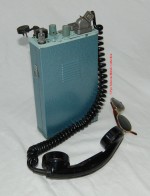 More
information
to
follow More
information
to
follow |
|||||||||||||||||||||||||||||||||||||||||
| Top of page | |||||||||||||||||||||||||||||||||||||||||
|
|
|||||||||||||||||||||||||||||||||||||||||
|
PF2 Pockefone 70
Series (1971)
|
|||||||||||||||||||||||||||||||||||||||||
| Top of page | |||||||||||||||||||||||||||||||||||||||||
|
|
|||||||||||||||||||||||||||||||||||||||||
|
PF3 (Pockefone 70
Series 1971)
A
variant of the PF2 with a higher power transmitter and improved
receiver sensitivity and selectivity.
Visually the product is identical to the PF2. |
|||||||||||||||||||||||||||||||||||||||||
| Top of page | |||||||||||||||||||||||||||||||||||||||||
|
|
|||||||||||||||||||||||||||||||||||||||||
|
PF5 (Pockefone 70
Series 1974)
|
|||||||||||||||||||||||||||||||||||||||||
| Top of page | |||||||||||||||||||||||||||||||||||||||||
|
|
|||||||||||||||||||||||||||||||||||||||||
|
PF6 UH (1975)
 A
single product portable radio which could be vehicle mounted and
quickly de-mounted for hand-held use. This multi-channel UHF
portable was designed
to a British Home Office requirement for use by the Police and was used
in conjunction with the BC18
vehicle adapter. A
single product portable radio which could be vehicle mounted and
quickly de-mounted for hand-held use. This multi-channel UHF
portable was designed
to a British Home Office requirement for use by the Police and was used
in conjunction with the BC18
vehicle adapter.Information and internal photographs to follow |
|||||||||||||||||||||||||||||||||||||||||
| Top of page | |||||||||||||||||||||||||||||||||||||||||
|
|
|||||||||||||||||||||||||||||||||||||||||
|
PF8 (1977)
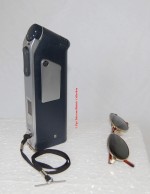 A
single
product multi-mode hand-held UHF portable with a novel styling which
resembled a large electric razor. The product could be used in
either
left or right hand, as a conventional PMR hand-held, or as a telephone
handset positioned against the face. A
single
product multi-mode hand-held UHF portable with a novel styling which
resembled a large electric razor. The product could be used in
either
left or right hand, as a conventional PMR hand-held, or as a telephone
handset positioned against the face.The PF8 gained public awareness and a degree of cult popularity from being featured in the 1970s British television series The Professionals. Information and internal photographs to follow |
|||||||||||||||||||||||||||||||||||||||||
| Top of page | |||||||||||||||||||||||||||||||||||||||||
|
|
|||||||||||||||||||||||||||||||||||||||||
|
PF9 (1975)
|
|||||||||||||||||||||||||||||||||||||||||
| Top of page | |||||||||||||||||||||||||||||||||||||||||
|
|
|||||||||||||||||||||||||||||||||||||||||
|
P5000 (1978)
 The
Pye P5000 series was the next major range of portables to follow the
PF70
series. It was described in the product literature as a universal
equipment, in that it was suitable for both hand-held and
body-worn
operation, rather than being made in two separate model variants, with
one type for each application. The
Pye P5000 series was the next major range of portables to follow the
PF70
series. It was described in the product literature as a universal
equipment, in that it was suitable for both hand-held and
body-worn
operation, rather than being made in two separate model variants, with
one type for each application.Instead, the P5000 used a multi-way facility connector which could be used to connect an external loudspeaker/microphone with external antenna or other peripherals. Internally the equipment used miniature plug-in modules which mounted onto a main motherboard. Each PCB module was mounted in a metal container for screening purposes. The choice of this form of construction was partly influenced by the success of equipments designed in the USA by Repco Inc. Information and internal photographs to follow |
|||||||||||||||||||||||||||||||||||||||||
| Top of page | |||||||||||||||||||||||||||||||||||||||||
|
|
|||||||||||||||||||||||||||||||||||||||||
|
PFH5000 (1981)
 The
Pye PFH5000 was a small series of VHF FM portables, with single channel and 4
channel versions, available in hand-held and body-worn
configurations. It used the P5000 series plug-in
modules and was the result of a
cost reduction exercise
carried out on the P5002 for Pye Telecom by
outside consultants. The
Pye PFH5000 was a small series of VHF FM portables, with single channel and 4
channel versions, available in hand-held and body-worn
configurations. It used the P5000 series plug-in
modules and was the result of a
cost reduction exercise
carried out on the P5002 for Pye Telecom by
outside consultants.The original P5000 transceiver series was fairly large and heavy and became costly to produce. The PFH5000 is slightly smaller, lighter, cheaper and does not feature the same external facility connector. It also uses a different battery and battery latch mechanism. Information and internal photographs to follow |
|||||||||||||||||||||||||||||||||||||||||
| Top of page | |||||||||||||||||||||||||||||||||||||||||
|
|
|||||||||||||||||||||||||||||||||||||||||
|
PF85 (1984)
The
PF85 was a three channel VHF and UHF FM
hand-held portable with an external facility connector, using similar case,
battery and
mechanics to the
PFX. It was the
first product of the PF85/PFX family to be introduced and remained in
production until
1989.
The standard equipment was a hand-held model and the inclusion of a multi-way facility connector enabled external microphones etc. to be used for body-worn applications and when mounted in a vehicle adaptor. A wide range of accessories and carrying aids were available, see the PF85/PFX accessories product leaflet below. Two case sizes were available for the PFX; a standard frame model to house the basic radio unit and those with CTCSS, and an extended frame model for those equipments fitted with larger selective calling modules. This product was in volume production when the change over from the Pye Telecom brand name to the Philips name occurred and equipment examples can be found with either the Pye or Philips brand label. Information and photographs to follow |
|||||||||||||||||||||||||||||||||||||||||
| Top of page | |||||||||||||||||||||||||||||||||||||||||
|
|
|||||||||||||||||||||||||||||||||||||||||
|
PFX (1985)
 The
first synthesised PMR portable radio designed by the Cambridge design
laboratories. The PFX was a major family of
VHF or UHF FM hand-held equipment using similar case, battery and
mechanics to the
PF85 and offering communication on up to 99 channel frequencies. The standard
equipment was a hand-held model and the
inclusion of a multi-way facility connector enabled external
microphones
etc. to be used for body-worn applications, as with the PF85. A
wide range of
accessories and carrying aids were available, see the PF85/PFX
accessories product leaflet. The
first synthesised PMR portable radio designed by the Cambridge design
laboratories. The PFX was a major family of
VHF or UHF FM hand-held equipment using similar case, battery and
mechanics to the
PF85 and offering communication on up to 99 channel frequencies. The standard
equipment was a hand-held model and the
inclusion of a multi-way facility connector enabled external
microphones
etc. to be used for body-worn applications, as with the PF85. A
wide range of
accessories and carrying aids were available, see the PF85/PFX
accessories product leaflet.Three case sizes were available for the PFX; a standard frame model to house the basic radio unit and those fitted only with CTCSS, an extended frame model for those equipments fitted with larger selective calling modules and a long extended frame model for applications such as the PFX-PM which featured military-grade digital encryption. The equipment remained in production until 1992 and today (2007) many are still in service. From about 2003 onwards the equipment began to be phased out of service with British Police and military as users moved to Tetra digital equipment. The Cambridgeshire Police changed to Tetra in June 2005. The illustration above shows the standard frame and extended frame models. The PFX was in production when the change over from the Pye Telecom brand name to the Philips name occurred and equipments can be found with either Pye or Philips brand label. All portable products introduced after the PFX were branded Philips until the company name changed to Simoco on 1st July 1996. The next physical change-over of product labeling took place from July 1996 to July 1997 and during that time products were manufactured bearing both the Philips brand and Simoco brand names. Information and photographs to follow |
|||||||||||||||||||||||||||||||||||||||||
| Top of page | |||||||||||||||||||||||||||||||||||||||||
|
|
|||||||||||||||||||||||||||||||||||||||||
|
502P & 512P (1985)
A Philiips branded
single product VHF
and UHF hand-held portable designed and manufactured by Marantz in
Japan and sold by Philips National Sales Organisations (NSO) to
countries which based their type approval specifications for radio
equipment on the USA EIA RS316A
standard rather than the European CEPT specifications.
Information and photographs to follow |
|||||||||||||||||||||||||||||||||||||||||
| Top of page | |||||||||||||||||||||||||||||||||||||||||
|
|
|||||||||||||||||||||||||||||||||||||||||
|
SXA/SNA series (1979
& 1982)
 A
family of fairly large hand-held VHF and UHF FM portables originally
designed by Philips in Hilversum, The
Netherlands
and based on the circuit design of the Philips LTS (Lotus)
mobile radiotelephone. The original design was crystal controlled
(SXA) and later a synthesised version (SNA) was designed by the
Philips group at at Wadeville, South Africa. Various versions
were manufactured in Holland, Spain, South Africa and
India. A
family of fairly large hand-held VHF and UHF FM portables originally
designed by Philips in Hilversum, The
Netherlands
and based on the circuit design of the Philips LTS (Lotus)
mobile radiotelephone. The original design was crystal controlled
(SXA) and later a synthesised version (SNA) was designed by the
Philips group at at Wadeville, South Africa. Various versions
were manufactured in Holland, Spain, South Africa and
India.A number of different configurations of the product were produced. See photograph of portables with a two-unit charger. Although the equipment series used many conventional discrete components, it also employed surface-mount components, thick film hybrids, RF power modules and various integrated circuits. The synthesiser circuit in the SNA used a similar hybrid configuration to the Pye MX294 mobile, which had a custom arrangement of the Philips-Mullard synthesiser integrated circuits and the Plessey synthesiser integrated circuits. See inside view of a Philips SNA synthesised model. |
|||||||||||||||||||||||||||||||||||||||||
| op of page | |||||||||||||||||||||||||||||||||||||||||
|
|
|||||||||||||||||||||||||||||||||||||||||
|
PR752 & PR762
(1988)
A pair of VHF and UHF FM synthesised hand-held portables designed and manufactured by EF Johnson of Minneapolis, USA and sold by Philips National Sales Organisations (NSO) to countries which based their type approval specifications for radio equipment on the USA EIA and MIL standards rather than the European CEPT specifications. |
|||||||||||||||||||||||||||||||||||||||||
| Top of page | |||||||||||||||||||||||||||||||||||||||||
|
|
|||||||||||||||||||||||||||||||||||||||||
|
PR710 (1989)
A synthesised multi-channel hand-held only portable, originally intended at the specification and planning stage to be the replacement for the PFX. The product design evolved to use a large rugged case and was marketed for tough commercial applications, rather than Police use. Information
and photographs to follow
|
|||||||||||||||||||||||||||||||||||||||||
| Top of page | |||||||||||||||||||||||||||||||||||||||||
|
|
|||||||||||||||||||||||||||||||||||||||||
|
PR720 (1990)
A
joint venture between EF Johnson of Minneapolis, USA to develop a hand
portable for use on MPT1327/MPT1343
private trunking networks.
Information and photographs to follow |
|||||||||||||||||||||||||||||||||||||||||
| Top of page | |||||||||||||||||||||||||||||||||||||||||
|
|
|||||||||||||||||||||||||||||||||||||||||
|
PRP70 (1991)
A
large family of broadband synthesised VHF and UHF FM portables
originally intended to be a replacement for the mid-market PFX.
The elegant technology, performance and cost of the final product
rendered it more suitable for upper market non-trunked applications
than the mid market, although it was sold to the UK Police resulting in
reduced profit margins.
Information and photographs to follow |
|||||||||||||||||||||||||||||||||||||||||
| Top of page | |||||||||||||||||||||||||||||||||||||||||
|
|
|||||||||||||||||||||||||||||||||||||||||
|
P1000 (OEM 1992)
A
mid market VHF and UHF FM hand portable for use on MPT1327/MPT1343
private trunking networks, sourced from Rohill BV of Hoogeveen, The
Netherlands. The P1000 consisted of a cosmetically restyled
variant of an existing transceiver unit from manufacturers Belcom,
Japan, fitted
with a Rohill trunking controller PCB and software. The final
product was supplied as a complete package to Philips by Rohill.
Information and photographs to follow |
|||||||||||||||||||||||||||||||||||||||||
| Top of page | |||||||||||||||||||||||||||||||||||||||||
|
|
|||||||||||||||||||||||||||||||||||||||||
|
LP70 (OEM 1994)
A
hand-held portable for use on MPT1327/MPT1343 public trunking networks
purchased on an OEM basis
as a complete package from the manufacturers OTE of Florence, Italy.
Information and photographs to follow |
|||||||||||||||||||||||||||||||||||||||||
| Top of page | |||||||||||||||||||||||||||||||||||||||||
|
|
|||||||||||||||||||||||||||||||||||||||||
| LP15 (OEM 1995) A small family of conventional analogue VHF and UHF hand held portables purchased on an OEM basis from the manufacturers in Korea. |
|||||||||||||||||||||||||||||||||||||||||
| Top of page | |||||||||||||||||||||||||||||||||||||||||
|
|
|||||||||||||||||||||||||||||||||||||||||
|
PRP80 (OEM 1994)
A
small single product hand-held portable for use on MPT1327/MPT1343
private trunking networks in Australia and South East Asia where the RF
unit was sourced
from the manufacturers Shinwa of Japan. The trunked signalling
hardware and software was designed by the Philips team in Clayton
Australia.
Information and photographs to follow |
|||||||||||||||||||||||||||||||||||||||||
| Top of page | |||||||||||||||||||||||||||||||||||||||||
|
|
|||||||||||||||||||||||||||||||||||||||||
|
SRP8000 (1997)
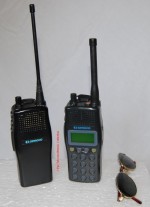 The Simoco SRP8000
was
a
modern family of VHF and UHF FM broadband synthesised
portables. Designed as
part of a development programme called MAP (Mobile and Portable) the
equipment series was intended to be a serious competitor to the
Motorola
GP300 product, which had come to dominate the PMR portable
market mid-tier sector. The Simoco SRP8000
was
a
modern family of VHF and UHF FM broadband synthesised
portables. Designed as
part of a development programme called MAP (Mobile and Portable) the
equipment series was intended to be a serious competitor to the
Motorola
GP300 product, which had come to dominate the PMR portable
market mid-tier sector.The equipment construction used a die-cast chassis with a plastic front cover moulding and rear mounted battery pack. For internal views see inside of chassis, front cover and battery pack and also outside front cover, battery pack and internal radio unit. The SRP8000 was also the last analogue PMR portable series designed before the Company (by then trading as Simoco) was broken up. Information and photographs to follow |
|||||||||||||||||||||||||||||||||||||||||
| Top of page | |||||||||||||||||||||||||||||||||||||||||
|
|
|||||||||||||||||||||||||||||||||||||||||
| SRP01 (1999) Launched in March 1999 the Simoco SRP01 was a fully Tetra compatible 1 Watt RF output handportable intended for Public Safety applications. It provided simplex or duplex speech, trunked or direct-mode operation and featured a 6 line by 20 character alpha-numeric LCD display. Photos to follow |
|||||||||||||||||||||||||||||||||||||||||
| Top of page | |||||||||||||||||||||||||||||||||||||||||
|
|
|||||||||||||||||||||||||||||||||||||||||
| SRP1000 1999) Also launched in March 1999 at the same time as the SRP01, the larger Simoco SRP1000 was a fully Tetra compatible 3 Watt RF output handportable intended for Emergency Services, Public Utilities, Transportation and professional business applications etc. It provided simplex or duplex speech, trunked or direct-mode operation and featured a 6 line by 20 character alpha-numeric LCD display. From 2002 the product was branded Sepura. Photos to follow |
|||||||||||||||||||||||||||||||||||||||||
| Top of page | |||||||||||||||||||||||||||||||||||||||||
|
|
|||||||||||||||||||||||||||||||||||||||||
| SRP2000 (2000) Information to follow |
|||||||||||||||||||||||||||||||||||||||||
| Top of page | |||||||||||||||||||||||||||||||||||||||||
|
|
|||||||||||||||||||||||||||||||||||||||||
| SRH3000 Series (2005) Information and photographs to follow |
|||||||||||||||||||||||||||||||||||||||||
| Top of page | |||||||||||||||||||||||||||||||||||||||||
|
|
|||||||||||||||||||||||||||||||||||||||||
|
Top of page |
|
Contact | Home |
|
V2.0 - Date 10-12-2005 updated 24-12-2009 |
|
Copyright © reserved 2002-2009 Pye Telecom History Group, Cambridge, England |